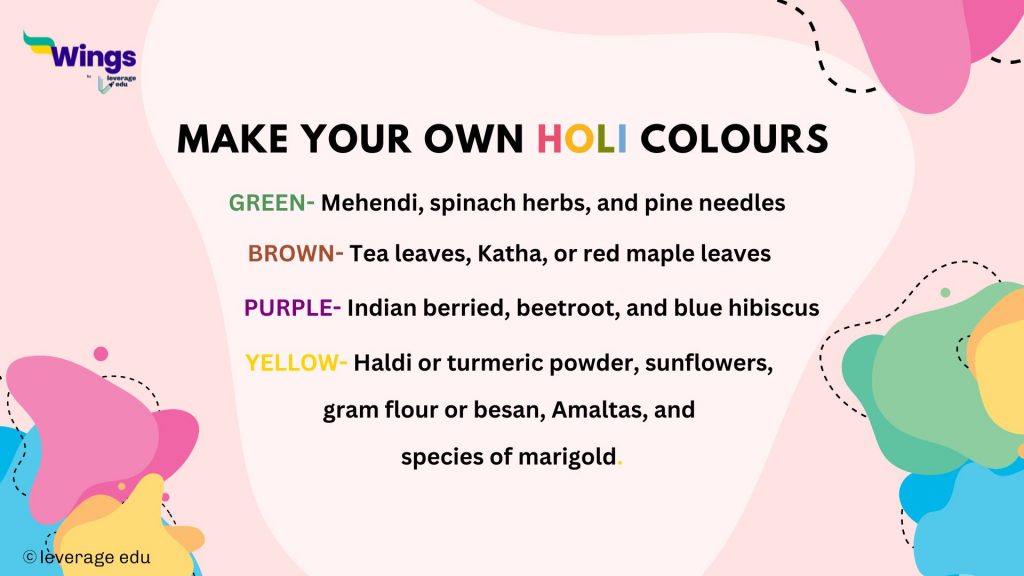Holi, or the festival of colors, is celebrated across the globe on the full moon day in the Phalgun month or March, as per the Gregorian calendar. According to popular beliefs, Holi is associated with numerous legends such as that of Radha and Krishna, Hiranyakashyap, his son Prahlad, Sistor Holika, Kama and Rati, and so on. However, amidst this burst of colors and sweet delicacies, have you ever wondered what would be the scientific reason behind Holi? Surprised? Keep on reading to learn more about the science behind the festival of Holi.
Contents
The Science Behind Holi
Below we have mentioned the different scientific reasons or explanations behind the celebration of the Holi festival in India.
Health Benefits
- In some parts of India, after the burning of Holika, people apply the remains on their forehead or mix it with the paste of sandalwood powder with Mango tree flowers and leaves to prepare a concoction full of numerous health benefits. Further, this mixture is consumed by people in other parts of the country, believing it promotes better health.
- During Holi, people feel extremely tired and lethargic primarily due to the change of weather from cold to hot. Luckily, Holi offers the perfect opportunity to play with colors, dance to the beats of dhol, and sing folk songs with their loved ones, leading to physical movements and physical rejuvenation.
Must Read: How to Take Care of the Environment During the Festival of Colours?
Changing Seasons and Skin Issues
Holi is played during the onset of the Spring season in India which comes between the end of winter and the beginning of summer. During this time, people often avoid bathing regularly and thus develop skin issues leading to severe infections. In addition to this, the accumulation of dirt and dust particles also emphasizes the importance of regular cleaning.
The science behind using organic and natural colors made from neem and turmeric is highlighted due to the inherent properties of these ingredients. While neem is known for its antibacterial properties, turmeric offers anti-inflammatory advantages.
Scientific Reason Behind Holika Dahan
It is believed that Holika Dahan is observed to burn all that is dry and pave the way for the liveliness of the spring season. Similarly, taking a Parikrama around the holy bonfire is believed to kill all bacteria on the body and cleanse it due to the heat released in the environment.
Must Read: Why do we Celebrate Holi? Interesting Legends Behind the Festival of Colors
Tips for Playing a Safe Holi
Here are some tips and tricks for playing a safer Holi this year.

- It is highly recommended to coat a thick layer of coconut oil, moisturizer, or Vaseline so that it can prevent direct contact with skin and colors
- You must also coat your hair with oil and lemon as it helps to prevent infection or dandruff caused by synthetic colors.
- Before playing Holi, drink lots and lots of water to avoid dehydration. Further, be careful while drinking water after playing Holi.
- If you are an alcohol lover, do not consume bhang or alcohol excessively, as it may lead to heart failure or attack.
- Try to cover the top parts of your body with dark colored cotton clothes as synthetic clothes can be sticky and heavy.
- Avoid wearing contact lenses as most people apply colors to your face immediately or surprisingly, which also leads to contact of color with the eyes.
- After playing Holi, use besan and milk cream mixture to remove excess colors from your body.
- If you itch in your eyes over a few hours, immediately consult a doctor.
Must Read: Tricks and Tips for a Hassle-Free Holi!
Science Behind Holi: Make your Own Colours

Markets at this point are usually flooded with chemical colors as these are comparatively cheaper than natural colors. Further chemical colours are highly demanded, and natural colours are unavailable in adequate quantities. However, numerous toxic components, such as chromium iodine, copper sulfate, etc., cause rashes, allergies, irritation, etc. Here are some colors and sources to make organic colors yourself at home.
| Name of the Colours | Name of the Sources |
| Green | Mehendi, spinach herbs, and pine needles |
| Brown | Haldi or turmeric powder, sunflowers, gram flour or besan, Amaltas, and species of marigold. |
| Yellow | Haldi or turmeric powder, sunflowers, gram flour or besan, Amaltas and species of marigold. |
| Purple | Indian berried, beetroot, and blue hibiscus |
Related Blogs
| Happy Holi Wishes | Holi Essay |
| Variation of Holi in Different States of India | Lathmar Holi |
| The Science Behind Holi | A Collection of Stories Related to Holi |
FAQs
Ans. The Holi festival is a method to celebrate the arrival of spring as well as a chance for individuals to start over and let all of their inhibitions go. One of the few occasions, when fervent Hindus can let loose, is during the Holi Festival when legend has it, the gods turn a blind eye.
Ans. Applying gulal on each other while celebrating Holi is cherished as an act of love. People play with different colors of gulal with their friends and family and ask god to bless them with the eternal love and bond of Lord Krishna and Radha.
Yes, the harmful chemicals used in the Holi colors, including lead, asbestos, silica, and mica, are damaging to the skin and eyes. Allergies, corneal abrasion conjunctivitis, and eye trauma are common eye issues.
This was all about the science behind Holi. For more such interesting updates, keep following Leverage Edu and continue to share your feedback in the comments section below.
 One app for all your study abroad needs
One app for all your study abroad needs














